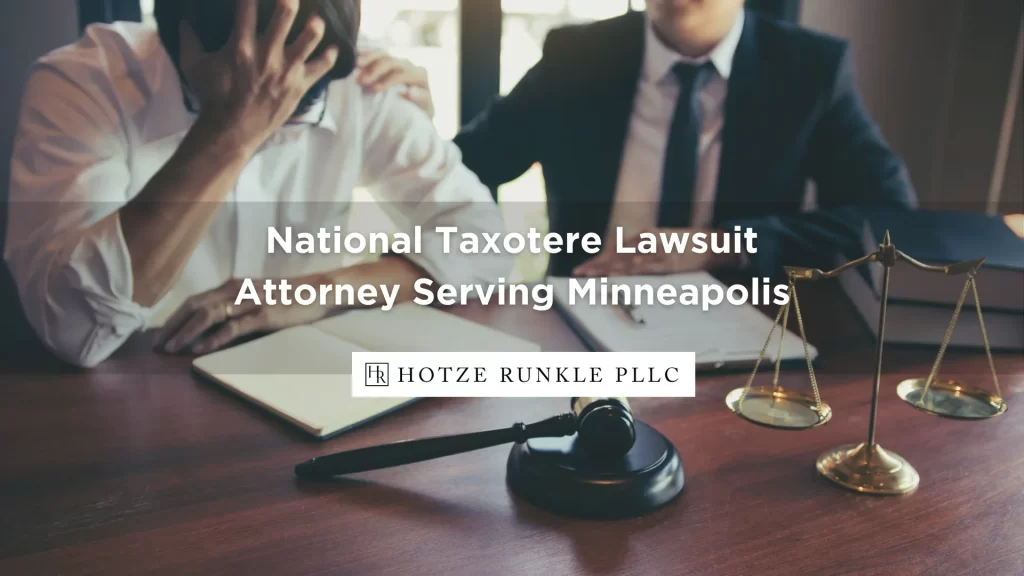
Did you take Taxotere to treat your cancer? Afterward, did you develop watery eyes or another symptom of Canalicular Stenosis? If so, Hotze Runkle PLLC is ready to represent you in your case and fight the makers of the chemotherapy drug.
We dedicate our time and attention to each client that hires us. We’ll begin working on your case immediately and handle every legal aspect so you can focus on treating the adverse side effects of your chemo treatment. Whether you received Taxotere once a week or once every three weeks, you could potentially recover financial compensation for your medical treatment and pain and suffering.
You can depend on our Taxotere Canalicular Stenosis lawsuit attorneys to protect your rights and pursue the maximum settlement or judgment you deserve. Take our quiz to find out if you may be qualified to sue the makers of Taxotere.
The Link Between Canalicular Stenosis and Taxotere
Taxotere is a drug used during chemotherapy at many hospitals such as the University of Minnesota Health to treat different types of cancer, such as breast cancer, lung cancer, stomach cancer, and prostate cancer. Sanofi-Aventis is the pharmaceutical company that created the drug to destroy cancer cells within the body and prevent them from spreading to other areas. Depending on the type of disease and its severity, you could receive Taxotere on a regimen of once a week, every two weeks, or every three weeks.
Canaliculi are structures within the eye area that funnel tears to the nasal cavity. If an infection develops, a blockage could form that prevents tears from traveling through the canaliculus as usual. This blockage causes the tears to build up on the surface of the eye and be released upon blinking.
This excessive eye-watering is known as epiphora. If caught early and treated, it’s possible to manage adverse symptoms and prevent it from progressing into a severe medical issue.
Medical researchers performed studies to find out why patients taking Taxotere chemo developed medical conditions involving their eyes. They discovered that the drug’s secretions interacted with various bodily fluids, particularly a person’s tears, as they traveled through the tear ducts. That direct contact can cause inflammation and infection, resulting in the closure of the canaliculi.
Symptoms You Might Develop from Taxotere Chemotherapy
During cancer treatment at a Minnesota treatment center like the Mayo Clinic with Taxotere, patients may notice excessive eye-watering before any other symptom. Often, the condition starts as a minor nuisance but becomes more severe as time progresses. Eventually, more symptoms develop and can lead to a severe medical condition called Canalicular Stenosis.
The most common symptoms cancer patients and survivors experience include:
- Blurry vision
- Swollen eyelids
- Central vision loss
- Dry eyes
- Clouding of the eye lens
- Light sensitivity
- Excessive eye-watering
- Headaches
- Eye infections
The side effects of Taxotere can be debilitating. It creates physical and emotional distress for the person experiencing them. It’s disheartening to fight cancer and face a new obstacle at the same time.
At Hotze Runkle PLLC, we have a dedicated team of Taxotere Canalicular Stenosis lawsuit attorneys that will fight hard to hold Sanofi-Aventis accountable for their negligence. You shouldn’t suffer the consequences of their actions.
Sanofi-Aventis knew about the dangers of their drug and decided not to disclose them to the public. They completely disregarded the health and safety of consumers throughout the country and should be financially responsible for the victims’ resulting expenses.
Is There a Cure for the Symptoms of Canalicular Stenosis?
Unfortunately, Canalicular Stenosis is a permanent medical condition. Once one or both canaliculi close, there’s nothing you can do to open them back up.
Your doctor may try to manage your symptoms with a procedure called dacryocystorhinostomy (DCR). The surgeon either places a stent or uses adjacent structures near the damaged canaliculus to create a new passageway for the tears to flow correctly.
Although effective at facilitating drainage into the nasal cavity, it’s an expensive surgery that comes with serious risks, such as:
- Blindness
- Significant facial scarring
- Uncontrollable bleeding
- Chronic eye infections
- Displaced stent
- Nerve and tissue damage
- Sinusitis
- Ineffective procedure
It’s crucial that you seek treatment for your symptoms as soon as you notice them. Some people ignore unusual reactions or pass them off as something that will ease once the chemo is over. If you wait too long, your condition could become irreversible. The sooner you notify your oncologist and ophthalmologist, the better chance you’ll have at managing your symptoms and preventing them from worsening.
Pursuing Compensation from a Lawsuit
If you treated your cancer with Taxotere chemotherapy at a hospital like St. Johns and developed any symptoms of Canalicular Stenosis, you might qualify for a lawsuit against Sanofi-Aventis. Drug companies are supposed to follow regulations when manufacturing and marketing their products. If they don’t disclose potential dangers to consumers, they could become liable for associated injuries.
In Minnesota, you can base your lawsuit on one of the following theories: negligence, strict liability, or breach of implied warranty. There’s a strict deadline you must follow, depending on which theory you choose.
Negligence
The statute of limitations for a negligence case is two years. There are five elements your lawyer will have to show existed to use negligence as a reason for suing Sanofi-Aventis:
- Duty: The manufacture owed you a legal duty of care;
- Breach of duty: They breached their duty;
- Cause in fact: If it wasn’t for their actions, you wouldn’t have gotten hurt:
- Proximate cause: Your injury was the direct result of the defendant’s actions; and
- Damages: You suffered damages from your injury.
Strict Liability
If you want to base your claim on strict liability, you must follow a four-year statute of limitations. This theory doesn’t rely on a careless act or failure to perform in a certain way to prevent harm to another. Instead, it relies on the fact that the company manufactured or sold a product that contained a defect.
Breach of Implied Warranty
The breach of implied warranty statute is four years. An implied warranty is a guarantee from a manufacturer or seller that the product will work as intended. If it doesn’t work the way it’s supposed to, and an injury occurs, that’s a breach of implied warranty. Your lawyer can discuss which of these legal theories may work best for your case.
The Damages You Could Get From a Taxotere Lawsuit
When you file a lawsuit, your goal is to recover compensation for your losses. Those losses are known as damages. They’re the result of an accident or injury and fall under three main categories.
Economic damages are expenses, such as:
- Lost wages
- Lost future earning capacity
- Past and future medical expenses
- Property damage
Non-economic damages are intangible losses, such as:
- Pain and suffering
- Emotional distress
- Scarring or disfigurement
- Inconvenience
- Loss of companionship
Punitive damages are supposed to punish the party responsible for your injury instead of compensating you for your losses. A jury reviews the details of your case to decide how much money in punitive damages you deserve. This type of financial award is rare and only occurs when there’s proof that the defendant showed a deliberate disregard for another’s safety.
Hotze Runkle PLLC Will Be by Your Side to Fight for Accountability
 Our Taxotere Canalicular Stenosis lawsuit attorneys understand the pain you endured and the impact your symptoms have on your daily routine. It can be debilitating when your eyes won’t stop watering and prevent you from working, driving, and performing simple tasks. We want to help you seek the compensation you deserve from Sanofi-Aventis.
Our Taxotere Canalicular Stenosis lawsuit attorneys understand the pain you endured and the impact your symptoms have on your daily routine. It can be debilitating when your eyes won’t stop watering and prevent you from working, driving, and performing simple tasks. We want to help you seek the compensation you deserve from Sanofi-Aventis.
When you hire us, you can depend on our team to handle every step of your case on your behalf. We’ll maintain open and honest communication, so you understand what’s happening and what to expect next. You’ll have access to our experienced and dedicated lawyers to ask questions and receive legal advice.
You shouldn’t go through this ordeal alone. Some personal injury victims attempt to handle their own cases. They believe they’ll save money that way because they won’t have to pay legal fees.
Unfortunately, that can do more harm than good. If you don’t seek legal representation, you won’t know the deadlines and procedures to follow. An experienced attorney can help you navigate the complicated legal road. We’ll file your lawsuit, collect relevant evidence, and argue your case in court. You won’t have to carry the burden of building your own case.
Hold Sanofi Liable for Their Actions
At Hotze Runkle PLLC, our Taxotere Canalicular Stenosis lawsuit attorneys will help you pursue the maximum compensation from the drug company. Your diagnosis after undergoing Taxotere chemo puts a strain on your life. It caused physical pain, financial hardship, and emotional harm. We’ll help you put the pieces of your life back together by going after the negligent manufacturer.
We care about the clients we work with, and we’ll provide individualized attention, so you feel like a priority. Upon our first meeting, we’ll get to know the details of your case and create a plan that fulfills your goals. We’ll offer legal advice and guide you in the right direction. You can depend on us to put your needs above ours at all times.
If you’re suffering from Canalicular Stenosis symptoms after cancer treatment with Taxotere, find out if you’re eligible for a lawsuit by taking our Case Evaluation Quiz.